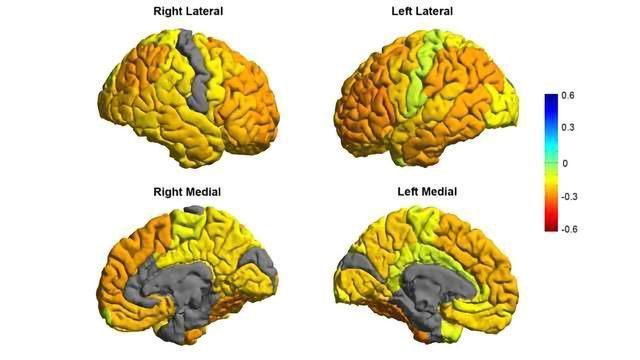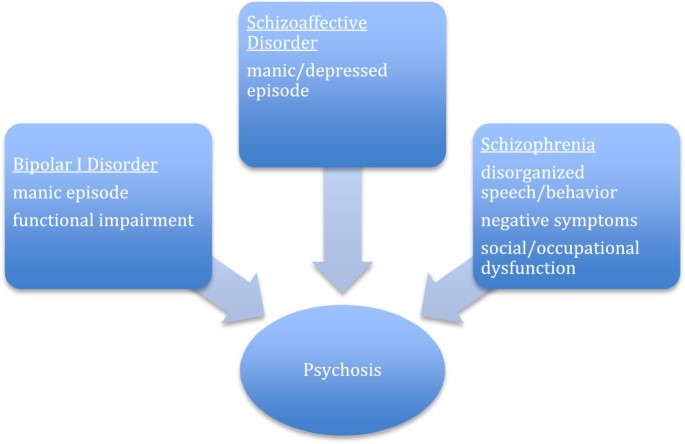A person may experince difficulty concentrating and problems with short term memory. This could include sadness numbness feeling hopeless not interested in everyday activities.
 Mri Study Of Bipolar Sufferers Reveals Structural Differences Technology Networks
Mri Study Of Bipolar Sufferers Reveals Structural Differences Technology Networks
Bipolar disorder is a mental illness characterized by extreme mood and behavior changes.

Effects of bipolar disorder on the brain. Bipolar disorder causes extreme mood changes that affect or disrupt daily life. Symptoms of depressive episodes include low energy and motivation lack of interest in daily activities and sometimes suicidal thoughts. They help build the proteins that make up the insulation around your neurons.
Bodily aches and pains are also quite common. Since bipolar disorder effects causes disruptions in brain activity the signals for the endocrine system are mixed up as well leading to fluctuations in hormones. Effects of Bipolar Disorder on the Endocrine system The endocrine system is in charge of the bodys hormone levels which are reliant on the signals from the brain.
Symptoms of manic episodes include showing extremely high energy in speech and activity agitation and a reduced need for sleep. Part of the phenotypic correlation r ph due to genetic effects is calculated by 085 r g h 2 OFC and that due to environmental effects by 015 r e e 2 OFC. In the largest MRI study to date on patients with bipolar disorder a global consortium published new research showing that people with the condition have differences in the brain regions that control inhibition and emotion.
Bearden et als review of what could be wrong with the brain reads like a neurologists laundry list from hell. Study shows that the cause of Bipolar Disorder is partly caused by a hidden problem with certain brain circuits. The Brain and Bipolar Disorder Experts believe bipolar disorder is partly caused by an underlying problem with specific brain circuits and the functioning of brain chemicals called.
Patients of bipolar disorder feel quite fatigued and lethargic because of the decreased amount of energy that results from inadequate sleep and food intake. Bipolar disorder BPD is associated with altered regional brain function during the performance of cognitive tasks. The only large effect size was that the adolescents with bipolar disorder had a smaller amygdala volume than the normal subjects.
Experts think its because you slowly lose amino acids. By revealing clear and consistent alterations in key brain regions the findings published in. A new study has found brain abnormalities in people with bipolar disorder.
The relative contribution of genetic and environmental risk factors for BPD to these changes has not yet been quantified. Bipolar affects the hippocampus neurotransmitters and the mitochondrial. Parts of the Brain Affected by Bipolar Disorder.
Many people with bipolar disorder cycle through extreme highs called mania and lows called depression and sometimes manic and depressive symptoms occur simultaneously. Studies have shown that bipolar disorder reduces the amount of gray matter in your brain. The parts of your brain that are usually full of gray matter help you.
Regardless of the type of bipolar disorder youre diagnosed with the condition can drastically change how you feel and think. Bipolar disorder has many effects on the brain and ones behavior. Chepenik LG1 Fredericks C Papademetris X Spencer L Lacadie C Wang F Pittman B Duncan JS Staib LH Duman RS Gelernter J Blumberg HP.
Bipolar Can Reduce The Amount of Gray Matter in Your Brain. Effects of Bipolar Disorder on the Body Bipolar disorder previously known as manic depression is a brain-based disorder. Also in contrast to the healthy subjects and studies on adults the bipolar adolescents had smaller total cerebral volume.
Bipolar disorder affects mood but it can also have an impact on stress levels and thinking ability. This condition is characterized by one or more occurrences of manic or. Ventricular enlargements cortical atrophy cerebellar vermal atrophy white matter hypertensities especially in the frontal cortex and basal ganglia structures greater left temporal lobe volume increased amygdala volume enlarged right hippocampal volume hypoplasmia of the medial temporal lobe and more.
Researchers suggest the loss or damage of the hippocampus can contribute to the mood disorder Healthline. Bipolar disorder is a mood disorder that causes highs and lows in mood. In conclusions bipolar disorders affects people because its a lifelong thing its more to it than just medication and its gone.
The neurotransmitter is a messenger of neurologic information from one cell to another. Physical Effects of Bipolar Disorder Fatigue. Effects of the brain-derived neurotrophic growth factor val66met variation on hippocampus morphology in bipolar disorder.
Study also shows that bipolar disorder can sometimes run in the family. We sought to address this issue in a functional neuroimaging study of people who varied in their risk for BPD. At one end the mood swings can cause the patient to experience episodes of depression.
The paths from A 1 to bipolar disorder and A 2 to brain activation are the square roots of their heritabilities h 2. Research shows bipolar disorder may damage the brain over time.
Meanwhile bipolar disorder 1 and 2 are described by manic and hypomanic episodes respectively as well as episodes of depression. The main criterion for the schizoaffective disorder diagnosis is the presence of psychotic symptoms for at least.
 Schizo Affective Disorder Vs Bipolar Bphope Com
Schizo Affective Disorder Vs Bipolar Bphope Com
Schizoaffective disorder is classified as two types bipolar type marked by episodes of mania and major depression and depressive type characterized by only major depressive episodes.

Bipolar with schizoaffective disorder. Schizoaffective disorder is a chronic mental health condition that involves symptoms of both schizophrenia and a mood disorder like major depressive disorder or bipolar disorder. Schizoaffective disorder bipolar type is characterized by some symptoms of schizophrenia and some symptoms of bipolar disorder. Symptoms of schizoaffective bipolar disorder include increased energy levels hallucinations and trouble concentrating.
Technically the Diagnostic and Statistical Manual of Mental Disorders DSM-based definition would differentiate a bipolar disorder episode with psychotic features from schizoaffective disorder bipolar type based on persistence of psychotic features outside of a distinctive mood episode. Schizoaffective bipolar disorder is when an individual experiences episodes of mania depression and symptoms of schizophrenia. Many people with schizoaffective disorder are often incorrectly diagnosed at first with bipolar disorder or schizophrenia.
A depressive type of schizoaffective disorder may be diagnosed when major depression occurs and a bipolar type of schizoaffective disorder is characterized by bouts of mania. Since bipolar disorder can in some instances produce psychotic behavior during manic episodes schizoaffective disorder is sometimes misclassified under the bipolar category as well. Extensive information on bipolar disorder symptoms causes treatment.
One unique feature of schizoaffective disorder is that severe mood disturbance and psychotic symptoms are not experienced simultaneously. Schizoaffective disorder is a psychiatric condition characterized by episodes of psychosis along with and independent from mood disorder symptoms. Bipolar Disorder with Psychotic Features In Schizoaffective Disorder the person must have a period when they have delusions or hallucinations for at least two weeks without any depression or mania.
With schizoaffective disorder bipolar type the patient will have some of the symptoms of schizophrenia-like delusions and paranoia while also having periods of mania. Schizoaffective disorder symptoms may vary from person to person. Schizoaffective disorder SZA SZD or SAD is a mental disorder characterized by abnormal thought processes and an unstable mood.
Bipolar disorder and schizoaffective disorder are actually in two separate mental illness categories. Episodes of mania occur in the bipolar type. Schizoaffective bipolar disorder is when an individual experiences episodes of mania depression and symptoms of schizophrenia.
The bipolar type is distinguished by symptoms of mania hypomania or mixed episode. Symptoms of schizoaffective bipolar disorder include increased energy levels hallucinations and trouble concentrating. Schizoaffective bipolar disorder can be treated with medications and therapy.
People with the condition experience psychotic symptoms such as hallucinations or delusions as well as symptoms of a mood disorder either bipolar type episodes of mania and sometimes depression or depressive type episodes of depression. Bipolar schizoaffective disorder is one of two types of schizoaffective disorder a chronic but treatable mental health condition. The diagnosis is made when the person has symptoms of both schizophrenia usually psychosis and a mood disordereither bipolar disorder or depression.
So in case other people are interested I made a new sub. Typically it first appears between the late teen years and early adulthood. The two types of schizoaffective disorder are bipolar and depressive.
Bipolar disorder affects approximately 22 percent of people in the United States. Similarly schizofamilies didnt quite do it because its a romantic relationship and those have their own issues. Schizoaffective disorder is a chronic mental health condition characterized primarily by symptoms of schizophrenia such as hallucinations or delusions and symptoms of a mood disorder such as mania and depression.
In other words inappropriate feelings given the environment. Schizoaffective bipolar disorder can be treated with medications and therapy. The other type is depressive.
During a manic episode you may alternate between feeling overly excited to. The condition is characterized by the symptoms of psychosis seen with schizophrenia as well as the symptoms of bipolar disorder which include cycles of mania and depression. Bipolar disorder is a mood disorder the primary symptoms are a disturbance in mood.
Children can also show signs of. The depressive type by symptoms of depression only. Sometimes though I feel a bit out of place because my partner has schizoaffective disorder bipolar type rather than strict bipolar.
The diagnosis is made when the patient has features of both schizophrenia and a mood disordereither bipolar disorder or depressionbut does not strictly meet diagnostic criteria for either alone.